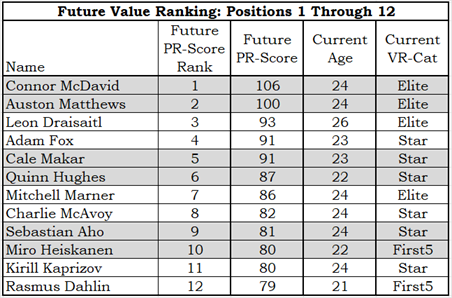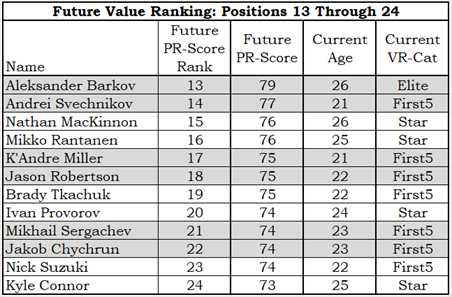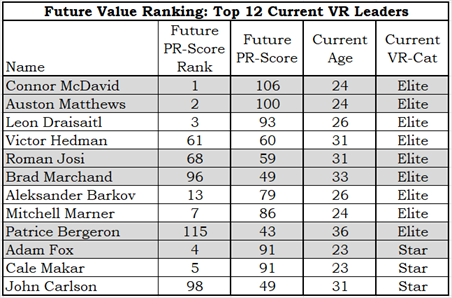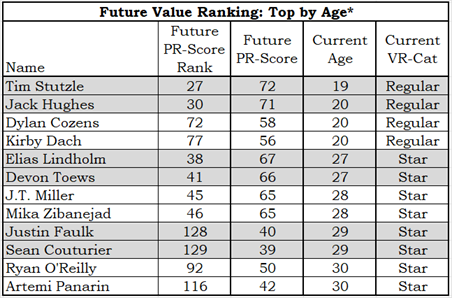Because you have been a good person all of your life, the Archangel Veronica has granted your biggest wish: you are now the general manager of an NHL team. Due to your kindness to animals, she also granted you a second wish: you get to pick the players for your team from all of the players currently in the NHL.
There are two drawbacks. You have to sign all of your players to max-term (8-year) contracts, and fifteen other people have been granted the same wish.
The sixteen of you will hold a draft. How do you pick your team? It would seem obvious that you have to pick the guys with the brightest future. And it just so happens that I have a process which predicts how well players will do in the future!
Hope vs. Reality
When I started developing a “future value” measure, I was hoping that a reasonably simple formula would be all I needed. I remembered that Bill James (a writer on baseball statistics in the 1970s and 1980s) had a formula for the future value of baseball players, and thought I’d just copy it and see how it worked.
I quickly found out that Mr. James’s formula didn’t work for hockey. As I didn’t find the original article in a quick rummage of my home library (a long way to say my bookshelf), I had no idea what was going on with the formula (I had found the formula, but not the accompanying explanation).
I tried to make the formula work, but whatever I tried produced results that never passed the subjective smell-test. It identified the wrong people as having the rosiest future (in my subjective opinion).
It was back to the drawing board.
Peak Value and its Application
One of my earlier STTB articles was on the peak value of players: when they reached it, how long they maintained it, and how much it declined post-peak. I have the current age and current Value-Rating for all players. This gave me a good feeling: I could determine the future value of players based on their current age, current value and likely change in value in the subsequent season.
For example, let’s take a fictional player named Huggy Damilton. Huggy was 28 years old last season, and his VR-Score was 7.87 (upper part of the VR-First5 category). What will his VR be next season? Based on the Peak Value article, a 28-year-old player in the VR-First5 category will retain 97% of his value in the following season. So Huggy should have a VR-Score of 7.63 next season. His one-year future value is 7.63.
For each future season, I calculated the player’s age that season, determined his change in VR-Score (the change factor), determined his new VR-Score by multiplying the previous VR-Score by the change factor, and then determined if this should be his last season.
Players stop playing when they lose effectiveness, and I picked a VR-Score that reflected that situation: 3.25. If a player’s VR-Score dipped below 3.25 (VR-Fringe) in a future season, it would be declared his final season.
Calculating Future Value
I went eight years into the future for all 572 players that had a VR-Score after the 2021/2022 season. For each player, for each future season, I went through the process outlined above. This time, the results did pass the subjective smell test. A few surprising results were clarified by remembering that future value does not include past value.
Kirill Kaprizov had 108 points last season; Johnny Gaudreau and Jonathon Huberdeau each had 115 points. But Kaprizov was 24 last year, while the Johns were 28. It’s pretty obvious you’d pick Kaprizov before either Gaudreau or Huberdeau, isn’t it? Kaprizov is at an age where he’ll either improve or at least maintain his scoring pace for a couple of years, while the other two guys are likely to start declining.
It’s exactly the same thing with the future value of players. Sidney Crosby is not in the top twenty in future value because I’m looking eight years into the future and he’s 34 years old. Ovechkin is 36. Brad Marchand is 33 and his playing-partner Patrice Bergeron is 36. While these players have good value right now, they have much less future value than players like Jason Robertson or Mathew Barzal.
The Top 24 Players Ranked by Future Value

In the top twelve players with the highest future values, only one player is older than 24, and he gets to play a lot with the #1 player on the list.
The top twelve are young players with great current value, as one would expect.

The next twelve players are still all very young (from my vantage point). Only three players in the top twenty-four are older than my son.
The top twenty-four are a good mix of forwards and defensemen.
The Future Value Ranking of the Top Twelve VR-Score Leaders

The top twelve players in the league right now, according to yours truly, are the players with the highest VR-Scores for 2021/2022.
As you can see, the older players in the current top twelve do not have the strong future that the younger players have.
They are excellent players right now. They just won’t be able to maintain their performance over the next eight years.
Future Value of Players of Certain Ages

The top twenty-four players were all aged 21 to 26. In this final list, I present the top two players at the ages of 19, 20, and 27 through 30. I stop at 30 because that brings me to twelve rows, which is the size of the other three tables in this article.
As only one player aged 19 has a VR (go Sens!), I included three 20-year-olds. It’s interesting the way the 29-year-old players are not following the pattern of the other 27+ players: the top two 27-year-olds ranked 38 and 41 in their future value; 28-year-olds came in 45th and 46th; 30 year-olds came in 92nd and 116th. While that pattern indicates the 29-year-olds should be in the 70s or 80s, they are 128th and 129th.
Summary
While I didn’t get my simple and elegant formula to produce a future value estimate, I did get a repeatable process that produces future value estimates.
The list it produces is subjectively correct: it feels right that the top 24 players it predicts will be the “most valuable” over the next eight seasons are correct. There certainly isn’t a dud in the bunch.
It will take many years to see if the list will be objectively correct. I hope that I’ve over-estimated the impact of age on a player’s career, and that the older players who have high current value but didn’t make the top 24 for future value prove me wrong.
